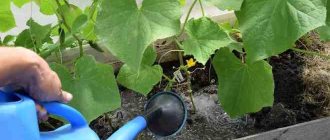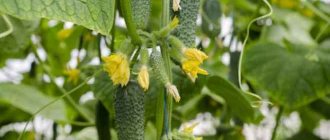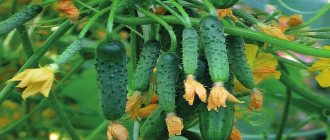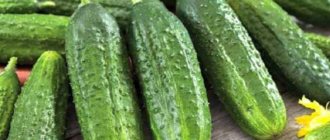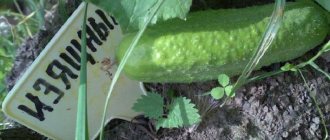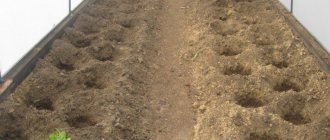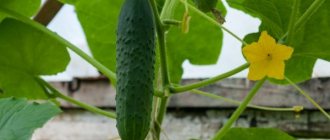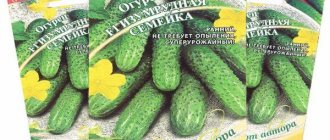Vegetable growing » Cucumbers
0
2616
Article rating
Kira Stoletova
The cucumber variety Furor is a hybrid. This is an early ripening plant, which allows housewives who choose it to get a harvest at the beginning of summer, and also protect the plantings from most diseases characteristic of this crop.
Characteristics of the cucumber variety Furor
Characteristics and description
The period from germination to fruiting averages from 37 to 39 days.
Flowering type is bouquet (2-4 fruits per node). The length of the fruit is about 10-12 centimeters, the diameter is about 3 centimeters, the color is dark green. The plant is quite large, its height can reach 3 m or more. The yield is about 16-19 kilograms per square meter. The average fruit weight is approximately 60 grams. The variety is intended mainly for growing indoors. Found widespread use for growing on a windowsill.
To plant “furor” cucumbers you need to go through the following steps:
- You need to choose a place to plant, taking into account where the sun rises, where it sets, and whether the place is too bright.
- Select a container for planting. You can take a plastic bottle, bucket or a special box for seedlings. It is better to choose a dark container to absorb more sunlight.
- Prepare the soil. The soil composition will include fertile soil, manure, peat, river sand, and wood ash. If you make calculations in glasses, the proportions will be such that you need to pour out soil and ash in two glasses. The remaining ingredients will be one glass each.
- Seed treatment. This complex procedure will consist of several stages. First, treat with a weak solution of potassium permanganate. Secondly, rinse with water. Third, soak in water at room temperature for twelve hours. Fourth, soak in a cloth or cotton wool and wait for white sprouts to appear.
- Feeding cucumbers "furor". Watering with warm room water will be daily, but fertilizing will begin only after two weeks. For the solution you will need superphosphate, potassium nitrate and magnesium sulfate. The proportion by grams will be 30 grams: 15 grams: 5 grams.
- Formation of lashes. When the third leaf appears, cut off the growing point. Subsequent pinching is done every two sheets.
Interesting! Furor cucumbers are an ingredient in many salads and appetizers. They have also found use in the cosmetology industry: various masks and lotions are made from them.
To get a spring harvest, you need to sow cucumbers of the “Furor” variety no later than mid-December. Sowing seeds should be done in small pots. To make seedlings appear faster, cover the top of the container with polyethylene. After 2 true leaves appear, the plants are transplanted into a larger pot with a mixture of leaf soil and sand; drainage must be placed at the bottom.
It is very important not to damage the root system when replanting. On the side shoots, as a rule, more ovaries are formed; therefore, when the lash of the plant reaches 15 centimeters, it must be pinched, this will allow the side shoots to develop
You need to feed the cucumber at least once every two weeks, this will allow the fruits to develop faster. Fertilizing is carried out with complex mineral fertilizers with a small amount of nitrogen. Water as needed.
Since cucumber is a light-loving plant, it needs additional lighting. You can use fluorescent lamps by installing them above the plant. To ensure that the light is distributed evenly, lashes longer than 20 centimeters should be tied to a support.
Diseases and parasites
Artist f1 cucumbers have strong immunity to powdery mildew, cladosporiosis and PTO. However, if the recommendations for planting and caring for the plant are not followed, the variety runs the risk of becoming infected with root rot, and the plant is also susceptible to invasion by spider mites and whiteflies. Let's consider a description of infections and methods of combating them.
Root rot
Root rot is an infection that occurs as a result of sudden changes in air temperature, excessive watering, and non-compliance with the rules of agrotechnical processes. With root rot, the lower leaves of the plant wilt, brown spots appear, flowers fall off, and fruit development slows down. Yellowing of the stems and leaves of the bushes is also observed.
To combat root rot, cucumbers are recommended to be treated with the chemical preparations Previkur Energy, Fundazol, Tiram and Copper sulfate, as well as the biological preparations Trichodermin, Fitolavin and Fitosporin.
Spider mite
Spider mites are small pests that cause damage to the entire crop of the Artist f1 variety. The insect is located on the foliage of the plant. When a spider mite invades, a white web forms on the leaves, fruit development slows down, and the tops become yellow. To combat spider mites, vegetable growers recommend treating cucumbers with Actellik, Apollo and Neoron substances.
Whitefly
Whitefly is a small insect that reaches a length of 1 mm and is white in color. During a whitefly invasion, a white coating forms on cucumbers, yellowing of the leaves of the plant, and an accumulation of midges on the back of the leaf. There is also a slowdown in the development of bushes, a decrease in the yield of the variety and drying of the leaves. To combat whitefly, vegetable growers recommend using the chemicals Aktara, Verticillin, Fufanon and boric acid.
Characteristic
The cucumber variety Furor was bred by agricultural breeders relatively recently, so it is not yet included in the State Register. The Furor variety has a similar description to the Bingo f1 type: the same high yield and bouquet type of flowering, parthenocarpic appearance and long-term fruiting for 1.5 months. But there is also a significant difference. The ripeness period of the Furor hybrid is ultra-early.
The fruits begin to be harvested 37-39 days after the first shoots appear. The yield is very high due to the extended fruiting of the variety. From one Furora bush, up to 7 kg of fruits are harvested per season.
Cucumbers are consumed fresh, used in salads and vegetable dishes, and can also be preserved for the winter. The variety has excellent transportability. Cucumbers can be transported over long distances without the risk of damaging the commercial quality of the fruit.
Bushes
The bushes of the Furor variety grow in the form of a thick stem with numerous side branches and medium-density foliage. The length of the main stem can reach 3 m.
The leaves are large, five-lobed. Furor blooms with a bouquet of bright yellow, five-pointed flowers followed by the formation of ovaries. 4-5 cucumbers grow on one node.
Fruit
The fruits of the Furor cucumber variety are formed in an elongated, slightly ribbed shape. The length of ripe cucumbers is 12 cm, the diameter is 3 cm, and the average weight is 60-80 grams. The color of cucumbers is dark green, the surface with small tubercles and small spines is light in color.
The pulp inside the fruit is tender, juicy, aromatic, without bitterness. The seeds do not develop, remaining very small and almost invisible. The peel of cucumbers is very thin, but quite dense. There are no voids inside.
Taste qualities of cucumbers
The type of fruiting in the Furor F1 hybrid is bunched. Up to 5 greens ripen in the leaf axil. Cylindrical cucumbers ripen small, 12 cm long, weighing up to 80 g. The fruits are covered with a dark green, thin, elastic peel with small tubercles.
The pulp is juicy, dense, fragrant, and does not form voids. The taste is sweet, without signs of bitterness. The seed chambers are small in size, the seeds are colorless, as they are in milky ripeness. Furor F1 is a universal hybrid. The fruits are consumed directly from the garden, for preparing vegetable salads and winter preservation.
How to grow your own
Before planting, it is necessary to correctly select the location of the beds, as well as the time of planting. Seeds are planted in March or April so that the seedlings are ready by May-June.
Furor loves sunny, windless places. The soil is preferably fertile, with a low concentration of nitrogen. The culture grows well in a mixture of turf with peat, humus, and sawdust. Future beds are prepared in the fall by digging up the soil and fertilizing it with compost.
Planting by seeds and seedlings
You can grow cucumbers by planting them in the ground right away or growing seedlings.
The seed method is simple. Rows are made in the garden bed, deepening them by 5 cm. Seeds are placed in them at an equal distance from each other, then watered. The seeds should be covered with straw or paper.
The seedling method is more labor-intensive, but it allows you to get the harvest a couple of weeks earlier. It has a number of features:
- seeds are sown in peat pots;
- the seedlings are transferred to the ground along with a clod of earth to preserve the roots;
- the pots are placed so that the roots of different seedlings do not intertwine;
- The seedlings are ready when there are five leaves and the height of the bush is at least 25 cm.
Growing in stages and care
Planting is done in the soil, leaving a distance of up to 35 cm between the seedlings. To ensure that the seedlings grow strong, follow this algorithm:
- The distance between seedlings is 30-40 cm. Per 1 sq. m no more than three plants are planted.
- Compost is poured into each hole, followed by a layer of soil.
- Each planting site is watered abundantly.
- The seedlings are transferred to the holes along with peat from the pot.
- The roots of the plants are covered with earth and compacted.
- Each seedling is watered using about 3 liters of water.
Further care consists of regular watering and fertilizing, loosening and pinching.
The hybrid is watered every 4-5 days, pouring about 5 liters of water under each bush. When the vegetable blooms, water it more often: every 3-4 days, and if it’s hot outside, then every day. The soil is loosened, and after flowering begins, loosening is stopped.
At the beginning of the summer season, it is recommended to feed the vegetable with mullein infusion prepared in a ratio of 1:10. Each seedling requires about 3 liters of fertilizer. Before the fruits appear, the plant is fed with superphosphates or viburnum salt at the rate of 30 g of the substance per 10 liters of water. The procedure is carried out every 2-3 weeks.
The plant, having reached a height of 2 m, needs to be pinched. All flowers and shoots are removed, leaving about six lateral shoots on the plant, approximately 30 cm long. They are removed when they reach a length of 40-50 cm.
Features of cultivation and possible difficulties
Growing features include:
- Requirement for light.
- Although Furor can tolerate short periods of drought, in general it loves moisture, especially during flowering and fruiting.
- A support is required on which the shoots will rise as they grow. It can be a wooden or wire frame.
- The root system of seedlings is fragile, which is why loosening should only be done between rows.
- It is not advisable to use soil rich in nitrogen for planting.
Diseases and pests
Furor is immune to many diseases characteristic of this vegetable. Among them:
- powdery mildew disease;
- olive spot;
- ordinary mosaic.
For preventive purposes, seedlings are sprayed with a solution of iodine or wood ash.
However, there are pests that can interfere with the growth and development of the plant:
- aphid;
- mole cricket;
- wireworm;
- spider mite;
- thrips;
- root-knot nematode.
To combat them, folk remedies are used:
- ash solutions;
- tobacco dust diluted in water;
- infusion of wormwood.
If traditional methods do not help, use the chemical preparations Iskra, Actellik or Aktara.
To prevent the appearance of root-knot nematodes, the soil is disinfected before planting, and gardening tools are also kept clean. Already contaminated soil should be replaced with new one.
The plant is more likely to get sick if the rules of agricultural technology are not followed. For example, the seedlings are planted too crowded or the greenhouse is not ventilated regularly.
Growing rules
According to the description of the variety and reviews, Furor cucumbers are grown in seedlings. This method is suitable for regions with recurrent frosts. The use of seedlings also increases the period of fruiting. In warm climates, seeds are planted directly in open ground.
Sowing time
Seeds are planted for seedlings in March-April. The planting material is not heated; it is enough to soak it for 20 minutes in a solution of a growth stimulator. For planting, prepare peat humus tablets or other nutrient soil. The containers are chosen to be small; one seed is placed in each of them. A thin layer of soil is poured on top and watered.
Cucumber shoots appear in warm weather. Therefore, they are covered with paper and left in a dark place. When the seeds germinate, they are moved to the window. Moisture is added as the soil dries. After 3 - 4 weeks, the plants are transferred to a permanent place. The seedlings should form 3 leaves.
For Furor F1 cucumbers, seeds can be planted directly into a greenhouse or open ground. Then the work is carried out in May-June, when the frosts have passed. If there is still a possibility of cold weather, the plantings are covered with agrofibre at night.
Selecting a location and preparing beds
Cucumbers prefer sunny places not exposed to winds. Be sure to prepare a trellis: a wooden frame or metal arches. The shoots will rise along them as they grow.
Cucumbers of the Furor F1 variety require fertile, drained soil with a low nitrogen concentration. If the soil is acidic, liming is done. The crop grows best in a substrate consisting of peat, humus, turf and sawdust in a ratio of 6:1:1:1.
Beds for cucumbers of the Furor F1 variety are prepared in the fall. The soil is dug up and fertilized with compost. The height of the beds is at least 25 cm.
How to plant correctly
When planting seeds of the Furor F1 variety, 30 - 35 cm are immediately left in the ground between the plants. To facilitate further care, the planting material is not buried in the soil, but covered with a layer of earth 5 - 10 mm thick. Then the soil is watered abundantly with warm water.
The procedure for planting cucumber seedlings Furor F1:
- First, make holes 40 cm deep. Leave 30 - 40 cm between plants. Per 1 sq. m plant no more than 3 plants.
- Compost is poured into each hole, then a layer of ordinary soil.
- The soil is well watered.
- Plants are transferred to the holes along with an earthen ball or peat tablet.
- The roots of the cucumbers are covered with soil and compacted.
- 3 liters of water are poured under each bush.
Aftercare for cucumbers
Cucumbers of the Furor F1 variety are watered every week. 4 - 5 liters of water are poured under each bush. To ensure better absorption of moisture, be sure to loosen the soil. During the flowering period, you can water cucumbers more often - every 3 - 4 days.
At the beginning of summer, cucumbers are fed with mullein infusion in a ratio of 1:10. 3 liters of fertilizer are poured under each plant. At the beginning of fruiting, superphosphate and potassium salt are used. The consumption of substances per 10 liters of water is 30 g. Between fertilizing, an interval of 2 - 3 weeks is made. This has a positive effect on the development of cucumbers by adding wood ash.
Forming a bush will help you get a high yield. When the main shoot reaches 2 m, its top is pinched. At the bottom, all flowers and shoots are removed. 6 lateral shoots 30 cm long are left on the plant. When they grow to 40 - 50 cm, they are also pinched.
Cucumber variety Furor (F1)
Everyone loves fresh, fragrant, crispy cucumbers. And it is desirable that they also ripen earlier. These are the requirements, according to consumers, that a cucumber should meet. But the breeders put into the Furor variety, which will be discussed, some more characteristics that experienced vegetable growers will definitely appreciate. The variety appeared on the seed market not long ago, so there is not much official information about it. It is not yet listed in the State Register of Breeding Achievements of Russia, but an application for its inclusion has been submitted, although for registration the originators (agro) slightly changed the name to “Furo”. The best performance during testing of the new product was demonstrated in a greenhouse, but in open ground the result was no less remarkable. Furor is a hybrid and is therefore labeled F1.
Description
The plant is indeterminate, very tall; in a greenhouse it can grow up to 3 meters or more. An owner of such a height may well be interesting for mass production cultivation, since during the growth process it constantly forms new flowers and ovaries, that is, the fruiting process continues continuously throughout the entire growing season. The internodes of the cucumber are short, which increases its yield. The side shoots are small, the foliage is good. The root system is well developed and powerful. The leaf blades are medium-sized, long-petiolate, entire, angular-heart-shaped, green, with a slightly corrugated surface. The type of fruiting of the variety is bunched. In each leaf axil, from 2 to 4, and sometimes up to 5 ovaries are formed.
Zelentsy are small, cylindrical, one-dimensional, even. The length recommended for harvesting is 10 - 12 cm. In cross section, the cucumber is 3.0 - 3.5 cm. The color is rich green, without light stripes. The skin is elastic, tender, thin, even near the stalk. The surface is covered with small tubercles, the pubescence is white. The pulp is juicy, tender, elastic, of good density, aromatic, without voids. The taste is excellent, sweet, without even a trace of bitterness. Medium sized seed chambers. The seeds are almost invisible; they are in the stage of milky ripeness, so they are not felt at all during consumption. The average weight of cucumbers is 60 - 80 grams.
Characteristics of the variety
- Hybrid Furor will delight you with an early harvest. From the moment the cotyledon leaves open until the first fruits begin to be collected, 37–39 days pass;
- judging by the bunched type of fruiting and the tallness of the plant, the yield should be very good. And the originators confirm this, declaring 18 kg per 1 square meter;
- the plant adapts well to changes in weather conditions, so the ovary does not fall off, almost all of it ripens;
- excellent immunity, the crop resists olive leaf spot, powdery mildew, and common cucumber mosaic virus;
- Harvesting is carried out every 2 - 3 days, but if for some reason the harvesting does not take place, then the cucumbers will not outgrow or become overripe;
- The variety is parthenocarpic and therefore does not require pollination. This feature of Furor allows you to guarantee a harvest in closed ground or in an open garden bed, regardless of weather conditions and the presence of pollinating insects;
- transportability is excellent; even after long-term transportation, the fruits will not show any defects. Keeping quality is also good; cucumbers do not turn yellow during storage;
- method of use is universal. In addition to being used in salads, cucumbers are great for pickling and pickling.
Agricultural technology
In order for the variety to form an early harvest, it must be grown in seedlings. The planting time is calculated taking into account the rapid growth of the crop; Furor seeds are sown approximately 25 days before the intended transplant. Seedlings that appear in insufficient light must be illuminated and kept at a temperature not lower than +27°C. After the appearance of side shoots, the temperature is lowered to +18°C or +23°C, watering is carried out only with warm water, you can spray it from a spray bottle. Seedlings ready for transplanting must have at least 6 true leaves. The recommended planting density is 3 - 4 pieces per 1 square meter. The soil must be nutritious, moisture- and breathable. A few days after transplantation, the bushes are tied to a trellis. At a height of 80 cm from the soil surface, all side shoots of the cucumber can be removed. On the remaining shoots, you need to preserve the ovary that appears in the axil of the first leaf, and then, after 2 or 3 leaves, limit the growth of the shoot. Care is simple - the plant needs to be provided with good watering and fertilizing. It is also necessary to carry out weeding and loosening.
Furor cucumbers: botanical description and characteristics, features of cultivation and care, photos
Many are waiting for the arrival of the new summer season in order to enjoy fresh vegetables grown with their own hands. And among them are the real symbols of summer - early, crisp, fragrant cucumbers. The Furor variety is one of the representatives of the domestic selection, which stands out for its excellent characteristics - long-term fruiting and excellent presentation of the fruit.
Botanical description
Furor cucumbers were bred by agricultural specialists not so long ago, so they have not yet been included in the State Register of the Russian Federation. In the application for registration of the variety it was designated as Furo. The decision to include it in the State Register will be made after all the necessary tests have been carried out and a detailed study of the characteristics of the variety. Furor is a hybrid and is therefore labeled F1.
Important! You should not save the seeds of hybrid plants for use in the next season, since in the second generation the positive characteristics of the variety will be scattered into parent forms, the quality of which will be unpredictable.
Fruits
The Furor variety brings a rich harvest of fruits with the following characteristics:
- one-dimensional, smooth, cylindrical in shape;
- with small tubercles and lightish pubescence on the surface;
- rich green color, without light stripes;
- up to 10–12 cm long, up to 3–3.5 cm in diameter;
- weighing between 60–80 g.
Cucumbers are distinguished by their delicate, thin, elastic skin. Their pulp is juicy, tender, quite dense, full-bodied, with a characteristic cucumber aroma. The taste of Furora fruits is pleasant, sweetish, without traces of bitterness. The medium-sized seed chambers contain seeds of milky ripeness, which are not felt during eating.
The fruits are characterized by versatility. They are eaten fresh as a snack or salad component. The variety is also excellent for homemade preparations - pickling, pickling, canning. In addition, various masks and lotions are made from cucumbers, especially for problem skin.
Kustov
Furor refers to indeterminate cultures, i.e. has virtually unlimited stem growth. As a result, the plant reaches a significant height, so in a greenhouse it can stretch up to 3 m or more. As it grows, a new ovary is constantly formed, which lengthens the fruiting period.
The side shoots of the variety are small and well leafy. The leaves of the plant are medium in size, green in color and solid, angular-heart-shaped with a slightly wrinkled surface. Furor's root system is powerful and well developed. The type of fruiting of the variety is bunched. In this case, 2–4 ovaries are formed in the axil of each leaf.
Characteristic
Thanks to breeding work, Furor cucumbers tolerate short-term moisture deficits, slight cold snaps and temperature changes. Also, the fruits are perfectly transported and stored.
Productivity
Thanks to extended fruiting, cucumbers of this variety bring a bountiful harvest. At the same time, up to 7 kg of aromatic cucumbers can be removed from one bush. And the yield of 1 m² of cucumber planting will be about 20 kg.
Moreover, the yield does not depend on where the crop is grown - in a greenhouse or on open ground. The yield and quality of cucumbers are influenced by many factors, including soil fertility, illumination of the area, correctness and timeliness of care measures.
Flowering and fruiting times
The variety shows early fruiting, i.e. 37–39 days pass between seed germination and the collection of the first ripe fruits. The type of flowering of the plant is bouquet, with 2–4 fruits tied in each node.
In this case, the duration of harvesting is 2-3 months. The Furor F1 variety is parthenocarpic, so it does not need insects or other pollinating plants.
Also learn how to grow cucumbers on a trellis in open ground.
Advantages and possible disadvantages
- According to the characteristics of the variety, its following advantages can be noted:
- early maturation;
- abundant fruiting;
- large fruits without internal voids;
- thin fruit skin;
- soft and juicy seeds;
- pleasant delicate, sweetish taste;
- resistance to characteristic diseases;
- the possibility of growing on personal farmsteads and on an industrial scale;
- versatility of fruit use.
The variety has no obvious disadvantages. The only thing that some gardeners note is the fairly high cost of seeds.
Planting a variety
Since the crop is quite sensitive to cold, the timing of planting cucumbers is extremely important. The authors of the variety recommend planting Furor in open ground around May-June, when the soil temperature warms up to +15°C.
In areas where return frosts are observed, it is better to grow the crop through seedlings. In warm climates, Furor seeds can be planted directly on the site. The beds for the crop are prepared in the fall by digging up the soil and feeding it with compost. The minimum height of the beds is 25 cm.
Important! Tomatoes, cabbage, garlic and onions are considered good predecessors of cucumbers. It is better not to plant the crop where zucchini, zucchini, pumpkins, melons or watermelons grew last year.
Cucumbers prefer sunny, low-wind areas with fertile, well-drained soil. If it is acidic, it should be limed.
The optimal substrate for the Furor variety is a mixture of peat, humus, turf and sawdust in a ratio of 6:1:1:1. Also on the site you need to provide supports along which the shoots of cucumbers can curl as they grow.
Metal arches or wooden trellises work well as such supports.
Sowing method
To plant the variety with seeds, you should prepare a bed where you arrange rows 5–7 cm deep. The seeds are planted at the same distance from each other (30–35 cm), after which the soil is carefully watered so that there is no excess moisture. For irrigation, use lukewarm, settled water.
Then you can organize a mini-greenhouse made of glass or polyethylene over the garden bed. If there is a high probability of frost returning, then at night the planting is covered with a layer of straw or agrofibre.
Seedling method
Furor seeds are planted for seedlings in March-April. They do not need to be warmed up; you just need to soak the seeds in a growth stimulator for about 20 minutes. They are planted in nutritious soil or in special peat tablets. It is better to choose small containers into which to pour the soil mixture and place 1 seed at a depth of 5–7 cm.
Then water thoroughly and leave in a warm place, covered with paper, glass or polyethylene.
After the seeds germinate, it is better to place them on a windowsill where the seedlings will receive sufficient sunlight. Watering should be done as needed.
Between seed germination and planting of cucumbers in a permanent plot, 3-4 weeks usually pass. The signal for the possibility of transplantation is the formation of at least 5 leaves and a plant height of at least 25 cm.
Furor F1 cucumber seedlings are planted in the following order:
- Holes are prepared with a depth of 40 cm and a step between them of 30–40 cm (there should be no more than 3 bushes per 1 m²).
- A portion of moistened nutrient soil is poured into the hole, where the bush is planted along with a lump of earth or in a peat tablet.
- The root system of cucumbers is covered with soil, which is carefully compacted.
- Each bush is watered with 3 liters of warm, settled water.
Further care of the bush
Caring for cucumbers involves carrying out mandatory activities - watering, fertilizing, weeding and loosening.
Watering and fertilizing
Plants are watered with warm water to approximately the depth of a spade bayonet (about 25 cm). Water can be heated naturally by placing the barrel in a place accessible to sunlight. You need to water in the morning or evening; the average frequency of watering during hot periods is once every 3–5 days.
Young plants usually need 5–10 liters of water per 1 m² of planting. When the plants begin to bloom, heavy watering should be stopped and resumed only after fruit set. After the moisture has been absorbed into the soil, the soil around the bushes should be carefully loosened.
Mulching the soil with peat or straw will reduce the frequency of watering. During the rainy season, plants do not need to be watered.
Organic and mineral fertilizers are used to feed cucumbers. It is better to feed in the evening after watering, avoiding getting fertilizer on the leaves of the plant.
Furor F1 is fed several times a season:
- After the formation of the first leaves - 3 liters of mullein solution (1 liter of mullein per 10 liters of water) per plant.
- 2-3 weeks after the first feeding - superphosphate and potassium salt (30 g per 10 liters of water).
- Foliar feeding as needed - 0.5 l per 1 m² with a solution of 12 g superphosphate, 7 g potassium chloride, 5 g urea and 10 l water.
Adding wood ash to the beds also has a beneficial effect on the development and health of plants.
Read how to feed cucumbers to grow and increase yield.
Loosening the soil
Loosening is necessary so that water and air have good access to the roots of the plants. Since when watering the top layer of soil becomes compacted and crusted, it should be carefully loosened after the water is absorbed.
If this is not done, the plant will develop worse and the ovary will fall off. Since the roots of cucumbers are shallow, they should be loosened carefully, at a depth of no more than 4 cm.
Weeding
Periodically, as necessary, you should weed the soil around the plants, removing weeds. The event is carried out so that weeds do not shade the cucumbers and do not take away their nutrients. If there are few weeds, you can manually pull them out by the roots.
Important! To obtain a bountiful harvest, it is necessary to shape the plant - pinching the top of the main shoot at a height of 2 m, lateral shoots at a level of 40–50 cm, removing all flowers and shoots in the lower part of the bush.
Prevention of diseases and pests
The most dangerous for cucumbers are aphids, mole crickets, wireworms, spider mites, and thrips.
To combat them, folk remedies are used:
- infusion of wormwood;
- wood ash;
- tobacco dust.
If these remedies do not help and the pests continue to cause great harm, insecticides (Aktara, Aktellik, Iskra) should be used, which have a paralyzing effect on pests. To prevent drugs from harming human health, they are not used for at least 3 weeks before harvest.
Although the variety has good immunity to powdery mildew, olive spot and common mosaic, if infection does occur, the plantings should be treated with Topaz or Fundazol solutions. If necessary, the procedure is repeated after 7–10 days. Preventive spraying of plants with a solution of wood ash or iodine will help prevent the development of diseases.
Additional preventive measures:
- aphids - ladybugs, infusion of onion or garlic, infusion of tobacco with laundry soap;
- spider mites - a water solution of laundry soap;
- root-knot nematode - soil replacement, treatment of affected soil with steam, winter freezing of the soil.
Also, for preventive purposes, when carrying out garden work, all tools should be periodically cleaned and disinfected.
Harvest and storage
The fruits of cucumbers of this variety are harvested regularly as they ripen, when they reach a size of 10–12 cm. The collection frequency is usually once every 1-2 days. During the period of mass fruiting, the beds are inspected twice a day - morning and evening.
Cucumbers are removed from the bush by twisting. Moreover, not only ripe specimens should be removed, but also damaged or irregularly shaped ones. This is done so that low-quality fruits do not weaken the bush. During harvesting, you should not tug or pull the cucumber vines too much.
The picked fruits are stored in the refrigerator in the vegetable compartment. Their shelf life is 1-2 weeks. If you follow all the growing recommendations, the Furor cucumber will certainly delight you with fresh, crisp fruits throughout its long fruiting period. The main thing is to choose a place for planting well and properly care for the plants.
Source: https://fermer.blog/bok/ogorod/ogurcy/sorta-ogurcov/partenokarpicheskie-sorta-ogurcov/6426-ogurcy-furor.html
Bush care
The plant needs proper care
Care involves following the rules regarding:
To do this, use warm water. Plants are watered once every 3-5 days, depending on weather conditions. The soil is moistened to a depth of 25 cm. You can place a barrel on the site, the water in which will be heated by the sun.
Loosening the soil
The procedure is carried out exclusively between rows of cucumbers so as not to damage the roots. Stop loosening the soil as soon as the plant begins to bloom.
The plant does not respond well to darkening, so the beds are thinned out. The distance between the beds should reach 60-70 cm, and the sprouts should be at a distance of 7-10 cm from each other.
Use organic and mineral fertilizers
Cucumbers are fed in the evening, being careful to avoid getting the solution on the leaves.
Pros and cons of the variety
Like other varieties of this crop, Mares f1 cucumbers have a number of positive features. However, unlike most varieties, they have virtually no negative characteristics. Let's consider a description of the pros and cons of growing the Maresa variety:
pros
- Excellent taste characteristics;
- Resistance to most diseases;
- Quite early and long-term fruiting;
- Weather resistance;
- Excellent presentation;
- Resistance to transportability;
- Versatility of use: suitable not only for fresh consumption, but also for preparing salads, as well as for pickling.
Description of the variety
The cucumber variety “Furor” or “Furo” was registered in the State Register in 2021. The plant is a hybrid. Seed material is not collected independently. It is recommended to contact the originator for seeds; It has its own trading platform on the Internet.
The plant is long-climbing and increases in length throughout the growing season. The main stem is cut to a length of 2.5 m. Lateral shoots are left through the leaf along the stem. The bush is designed according to the diagram.
At the bottom and top of the stem, 2-3 ovaries are left on each branch. In the central part, 4-5 ovaries can form. The rest of the branch is cut off.
Cucumbers develop well when grown vertically using trellises. The stem and branches are placed along the trellis structure so that they are well ventilated, heated and illuminated.
When growing cucumbers of the Furor F1 variety in open ground, trellises with plants protect them from scorching sun rays. According to reviews from gardeners, it is better to use a green mosquito net. You can install a canopy made of transparent polycarbonate.
If the cucumbers are in a greenhouse, then no protection is required. Film, polycarbonate or glass frames normally protect plantings from the hot sun, but a protective mesh is also installed in them. Greenhouses are ventilated; the air in them should not be over-humidified and the temperature should not rise.
Furor F1 cucumbers belong to ultra-early crops. Planting in greenhouses is carried out in early May, if the air in it warms up to 15 C at night, and the soil temperature is more than 12 C.
The first harvest is harvested in mid-June. In greenhouses, the ovary forms and develops faster than in an open garden bed. Fruiting begins after 37-39 days. The period lasts 2-2.5 months:
variety Furor (Furo) parthenocarpic. 2-3 inflorescences develop in the leaf axils
Pollination is not required, which is important for greenhouse cultivation; the yield under film covers is 20 kg/m2, if we take into account the number of fruits with marketable characteristics. The yield of commercial products is close to 100%; greens size 10-12 cm, weight 65-90 g
These characteristics classify the Furor variety as a gherkin type; cucumbers are dark green, without light stripes, and have the shape of a small cylinder; the peel is quite dense. This allows you to transport vegetables over long distances; the surface is bumpy. The tubercles are medium in size, with white spines; The Furo variety has good immunity. Plants do not suffer from typical diseases such as powdery mildew, cladosporiosis, mosaic. To prevent putrefactive infections, maintain humidity in the greenhouse and tie up the vines in a timely manner. Greens can rot if they are left lying on wet soil.
Cucumbers are grown in a fertile area. A well-lit area is chosen for them. The best predecessors for them are root vegetables. Do not plant a bed for cucumbers for 2 years in a row. It is not recommended to consider a site where melons and melons were grown.
Main characteristics of the variety
Furor F1 cucumbers are resistant to weather disasters: cold snaps and temperature changes. Plants tolerate short droughts well. The ovaries do not fall off when weather conditions change.
The fruits tolerate transportation without problems. Therefore, they are recommended to be grown both in private and on farms. During long-term storage, no defects appear on the skin: dents, drying out, yellowing.
Productivity
Fruiting of the Furor F1 variety begins early. The period from seed germination to harvesting takes 37 - 39 days. The harvest is harvested within 2 - 3 months.
Thanks to extended fruiting, Furor F1 cucumbers produce a high yield. Up to 7 kg of fruits are harvested from one plant. Productivity of the variety per 1 sq. m of planting will be from 20 kg or more.
The yield of cucumbers is positively affected by care: the supply of moisture, fertilizers, pinching shoots. Access to sunlight and soil fertility are also of great importance.
The Furor F1 variety is parthenocarpic. Cucumbers do not require bees or other pollinators to form ovaries. Productivity remains high when growing the hybrid in a greenhouse and open ground.
Resistance to pests and diseases
Cucumbers need additional protection from pests. The most dangerous to plants are aphids, mole crickets, wireworms, spider mites, and thrips. To combat pests, folk remedies are used: wood ash, tobacco dust, wormwood infusions. If insects cause serious damage to plantings, then insecticides are used. These are products containing substances that paralyze pests. The most effective solutions are Actellik, Iskra, Aktara.
The Furor F1 variety resists the pathogens of powdery mildew, olive spot and common mosaic virus. The risk of infection increases in cool and damp weather. Therefore, it is important to follow agricultural techniques, ventilate the greenhouse or greenhouse, and not plant plants too close to each other.
If signs of damage appear on the cucumbers, they are treated with a solution of the drug Topaz or Fundazol. The treatment is repeated after 7 - 10 days. Preventive spraying with a solution of iodine or wood ash helps to avoid diseases.
Pros and cons of a hybrid
Advantages of the cucumber variety Furor F1:
- early maturation;
- abundant fruiting;
- presentation of the fruit;
- good taste;
- universal application;
- resistance to major diseases.
Read also: Melon “Cinderella”: description, reviews, growing methods
Cucumbers of the Furor F1 variety do not have any obvious deficiencies. The main disadvantage is the higher cost of seeds. The cost of 5 seeds is 35 - 45 rubles.
Characteristics of the cucumber variety Furor
The cucumber variety Furor is a hybrid. This is an early ripening plant, which allows housewives who choose it to get a harvest at the beginning of summer, and also protect the plantings from most diseases characteristic of this crop.
Characteristics of the cucumber variety Furor
Description of the variety
The period from germination to fruiting averages from 37 to 39 days. Flowering type is bouquet (2-4 fruits per node). The length of the fruit is about 10-12 cm, the diameter is about 3 cm, the color is dark green. The plant is quite large, its height can reach 3 m or more. Productivity is about 16-19 kg per 1 sq. m. The average weight of the fruit is approximately 60 g.
Furor cucumbers are an ingredient in many salads and snacks. They have also found use in the cosmetology industry: various masks and lotions are made from them.
Advantages
According to the description, the Furor variety has the following advantages:
- excellent taste characteristics: delicate, sweetish taste;
- heavy fruit without voids;
- the possibility of growing both in summer cottages and on a production scale for sale;
- thin skin;
- soft and juicy seeds;
- versatility.
Sowing method
First, prepare the bed, deepening the rows in it by 5-7 cm for seeds. They are sown at the same distance from each other, then carefully watered, trying not to saturate the soil with moisture. Seeds on the surface should be covered with paper or glass; at night you can cover them with a straw blanket.
Seedling method
You can use the seedling method. This speeds up fruiting by about 2 weeks. In doing so, a number of recommendations are followed:
- use peat pots to avoid damaging the roots;
- sprouts are planted in the ground without removing them from the pots in order to achieve maximum survival rate;
- before sowing, add moist nutrient soil to the pots;
- moisten the soil;
- arrange the pots so that there is a distance between them that prevents the roots from intertwining;
- make sure that before planting on the site, the seedlings have at least 5 leaves and reach a height of 25 cm.
The plant needs proper care
Care involves following the rules regarding:
Watering
To do this, use warm water. Plants are watered once every 3-5 days, depending on weather conditions. The soil is moistened to a depth of 25 cm. You can place a barrel on the site, the water in which will be heated by the sun.
Loosening the soil
The procedure is carried out exclusively between rows of cucumbers so as not to damage the roots. Stop loosening the soil as soon as the plant begins to bloom.
Weeding
The plant does not respond well to darkening, so the beds are thinned out. The distance between the beds should reach 60-70 cm, and the sprouts should be at a distance of 7-10 cm from each other.
Top dressing
Use organic and mineral fertilizers
Cucumbers are fed in the evening, being careful to avoid getting the solution on the leaves.
Pest treatment
Cucumber Furor suffers from a number of pests:
Appears in July and August. A large number of pests on the leaves leads to the death of the plant. Ladybugs, which are attracted with dill or mustard greens, help fight them. Cucumbers are also treated against aphids with an infusion of onion or garlic or an infusion of tobacco with the addition of laundry soap.
Spider mite
This parasite infects plants in greenhouses. To combat it, store-bought remedies are most often used. A soap solution also helps.
Growing cucumbers Furor F1
To get a harvest in 40 days, it is necessary to carry out timely planting. Cucumbers are susceptible to cold, so producers advise growing the variety under film cover or sowing Furor F1 cucumber seeds in open beds only after the soil has warmed to + 15 °C.
Planting seedlings
To harvest early harvest, it is better to grow cucumbers through seedlings. Seeds are sown 30 days before planting in a permanent place. For this:
- The seeds are soaked for 20 minutes in a growth stimulator.
- The cups are filled with nutritious soil.
- The seed is buried 2 cm.
- To obtain early shoots, the seeds need to create greenhouse conditions.
- After germination, the containers are moved to the brightest place.
- At the age of 4 weeks, when 5 true leaves have formed, the plant can be transplanted to a permanent location. The planting density of the Furor F1 hybrid is 4 plants per 1 sq. m.
Important! Good growth, development and productivity are influenced by compliance with crop rotation. Cucumbers grow well after tomatoes, cabbage, garlic and onions. It is not recommended to plant cucumbers after zucchini, pumpkin and watermelon.
Landing in the ground
Hybrid Furor F1 prefers to grow in a sunny area. Before the shoots appear, a trellis must be installed: metal arcs, mesh or wooden frame. The shoots will rise along them as they grow, thereby facilitating care and harvesting.
Planting seeds in open ground is carried out after the end of spring frosts. Since cucumbers grow well and bear fruit in nutritious soil, the bed is dug up and manure or rotted compost is added. In a prepared, moistened bed, make rows 2-3 cm deep, plant the seeds at a distance of 30 cm, sprinkle with soil and mulch the soil.
Advice! When growing cucumbers in regions with an unstable climate, the planting material is covered with agrofibre before emergence.
Watering and fertilizing
Watering is carried out as the soil dries out. For each plant, 5 liters of warm water are used to moisten the soil to a depth of 25 cm. After irrigation, the row spacing is loosened and mulched. Mulch will conserve moisture, stop the growth of weeds, and act as an additional fertilizer.
Advice! At the beginning of flowering, loosening is stopped and watering is increased.
At the beginning of summer, cucumber bushes are fed with mullein at a rate of 1:10. 3 liters of fertilizer are poured under each plant. At the beginning of fruiting, phosphorus-potassium fertilizing is carried out, diluted strictly according to the instructions. The interval between applying fertilizer should be at least 1 month. Fertilizing is applied in the morning or evening, only after abundant irrigation.
Formation
To get a rich harvest, the cucumber bush must be properly formed. At a height of 30 cm, all side shoots are removed. It is also necessary to remove all flowers and ovaries up to the 5th leaf. Next, the plant is formed; for this purpose, 6 lateral shoots 30 cm long are left. When they grow to half a meter, the top is pinched. After the main stem reaches 3 m, the growth of the plant is limited.
Protection from diseases and pests
As the description, photos and reviews from gardeners show, the Furor F1 cucumber has strong immunity to many diseases. But often insect pests settle on the plant if the care rules are not followed. These include:
- Aphids – often appear in mid-summer. If not treated promptly, aphids can destroy the entire plant. You can help a cucumber by treating it with onion or garlic, alkaline infusion.
- Spider mites - often appear on cucumbers grown in a greenhouse. To combat the pest, a soap solution or store-bought product will help.
- Root-knot nematode is a pest that attacks the root system. When a disease is detected, about half a meter of affected soil is removed, replacing it with healthy soil.
Diseases and parasites
Mares f1 cucumbers are resistant to most diseases. However, like the Aquarius variety, Maresa is subject to invasion by pests such as aphids or whiteflies.
Aphid
Aphids are the smallest pest. As a rule, aphids are located under the leaves or on the shoots and flowers of cucumbers. The first signs of a pest are drying and curling of the cucumbers.
For preventive spraying, use a solution of karbofos (for 10 liters of hot water there are 2 tablespoons of karbofos).
Whitefly
Whitefly is a small type of pest. In appearance, the whitefly resembles a moth. Insects appear if cucumbers are grown in a greenhouse or greenhouse. Confidor Extra is used for prevention.
Pest treatment
Cucumber Furor suffers from a number of pests:
Appears in July and August. A large number of pests on the leaves leads to the death of the plant. Ladybugs, which are attracted with dill or mustard greens, help fight them. Cucumbers are also treated against aphids with an infusion of onion or garlic or an infusion of tobacco with the addition of laundry soap.
Read also: How and when to feed strawberries with yeast
Spider mite
This parasite infects plants in greenhouses. To combat it, store-bought remedies are most often used. A soap solution also helps.
Planting a variety
First of all, you should pay attention to the timing of planting. Cucumbers are sensitive to cold
The soil temperature warms up to at least 15°C. Manufacturers recommend planting Furor seeds in May or June.
Sowing method
First, prepare the bed, deepening the rows in it by 5-7 cm for seeds. They are sown at the same distance from each other, then carefully watered, trying not to saturate the soil with moisture. Seeds on the surface should be covered with paper or glass; at night you can cover them with a straw blanket.
Seedling method
You can use the seedling method. This speeds up fruiting by about 2 weeks. In doing so, a number of recommendations are followed:
- use peat pots to avoid damaging the roots;
- sprouts are planted in the ground without removing them from the pots in order to achieve maximum survival rate;
- before sowing, add moist nutrient soil to the pots;
- moisten the soil;
- arrange the pots so that there is a distance between them that prevents the roots from intertwining;
- make sure that before planting on the site, the seedlings have at least 5 leaves and reach a height of 25 cm.
Description
This variety has a powerful root system. It also has well-developed stems that grow up to 3 meters. The shoots are shorter, but have a large amount of green mass. The leaves are small in size, with long stalks. They are a little corrugated. They have a green color.
Furor has a bouquet type of flowering. Up to 4 flowers are tied in one knot.
The pulp of the fruit is juicy and tender, without voids. The taste is sweetish, bitterness is completely absent. The seeds inside the fruit are small. They are not felt during use.
Furor is used fresh, as well as canned, salted and pickled.
The variety is resistant to adverse weather conditions. It tolerates drought, cool weather, and sudden temperature changes well.
Cucumbers ripen 1.5 months after planting the seeds in open ground. The crop produces its maximum yield within 3 months. Up to 7 kg of fruits are harvested from one bush.
Description of cucumbers
Furor is grown both in open and closed ground. However, in a greenhouse with proper care, the plant gives a greater yield: from 1 sq. m from 20 kg of cucumbers.
The length of the plant reaches 3 m. The leaves are small, the petioles are long. The leaf has the shape of an angular heart with a slightly corrugated surface.
Distinctive features
The hybrid bears fruits that are even, not very large, and approximately the same size. They have small tubercles, as well as whitish fluff.
The distinctive features of cucumber include:
- fruit shape in the form of a cylinder;
- diameter about 3 cm;
- length up to 12 cm;
- fetal weight 60-80 g;
- green uniform color without stripes.
Composition, properties, benefits, calorie content
This vegetable is valued because it contains a lot of water (up to 95%) and substances beneficial to the body:
- vitamins A, C, PP, group B;
- zinc;
- manganese;
- sodium;
- copper;
- beta-carotene;
- potassium;
- folic acid;
- iron;
- chromium;
- magnesium;
- iodine;
- phosphorus.
Cucumbers have the property of flushing the kidneys, removing toxins and heavy metal salts. This vegetable is rich in fiber, which allows you to gently cleanse the intestines, stimulating its work. Positive properties also include:
- the ability to prevent the appearance of cholesterol plaques;
- positive effect on the thyroid gland;
- prevention of a spectrum of cardiovascular diseases.
The calorie content of cucumbers is only 15 kcal per 100 g, which makes it an excellent dietary product.
The pulp is juicy, tender and dense, without voids inside. The aroma is typical cucumber. Furor has a sweet taste without bitterness, which is especially appreciated by lovers of this vegetable.
Characteristics
The plant tolerates weather changes quite steadfastly: warming or, conversely, cooling.
Furor is perfect for both personal plots and large farms growing crops for sale.
The plant is capable of producing a harvest approximately 40 days after the seeds germinate.
Furor needs:
- regular watering;
- feeding;
- pinching shoots;
- in lighting;
- fertile soil.
Furor F1 is a parthenocarpic plant, that is, the plant does not require pollen to form ovaries. A high yield will be obtained without the participation of pollinating insects.
Another important quality is good transportability. The fruits can be stored for a long time and do not develop any defects.
Agricultural technology
In order for the variety to form an early harvest, it must be grown in seedlings. The planting time is calculated taking into account the rapid growth of the crop; Furor seeds are sown approximately 25 days before the intended transplant. Seedlings that appear in insufficient light must be illuminated and kept at a temperature not lower than +27°C. After the appearance of side shoots, the temperature is lowered to +18°C or +23°C, watering is carried out only with warm water, you can spray it from a spray bottle. Seedlings ready for transplanting must have at least 6 true leaves. The recommended planting density is 3 - 4 pieces per 1 square meter. The soil must be nutritious, moisture- and breathable. A few days after transplantation, the bushes are tied to a trellis. At a height of 80 cm from the soil surface, all side shoots of the cucumber can be removed. On the remaining shoots, you need to preserve the ovary that appears in the axil of the first leaf, and then, after 2 or 3 leaves, limit the growth of the shoot. Care is simple - the plant needs to be provided with good watering and fertilizing. It is also necessary to carry out weeding and loosening.
Furor, or Furo, showed very impressive results during test cultivation. Resistance to diseases, excellent productivity and the continuous process of fruit formation during the growing season make the variety interesting not only for growing on private farms, but also on an industrial scale. Despite the fact that the variety is new, no shortcomings have been identified in the process of its cultivation. But vegetable growers will have to purchase cucumber seeds annually.
Many people love fresh, crispy cucumbers, especially if they are grown with love and in their own garden. There are a lot of varieties, they differ in size, ripening period and taste. The Furor F1 cucumber is considered one of the best early ripening hybrids. To grow a decent harvest, you need to study the description and reviews of Furor F1 cucumbers.
Productivity
Furor F1 is a high-yielding hybrid. Due to the tall growth and bunch type of fruiting, with proper care from 1 sq. m you can collect up to 18 kg of greens. Harvesting is carried out several times a week, but thanks to the varietal characteristics, ripe cucumbers do not outgrow or overripe. Due to its high yield, the hybrid can be grown on an industrial scale.
The variety does not require pollination, so it can be planted both in open beds and under film cover. Regardless of weather conditions and pollinating insects, the hybrid will bear fruit abundantly throughout the growing season.

